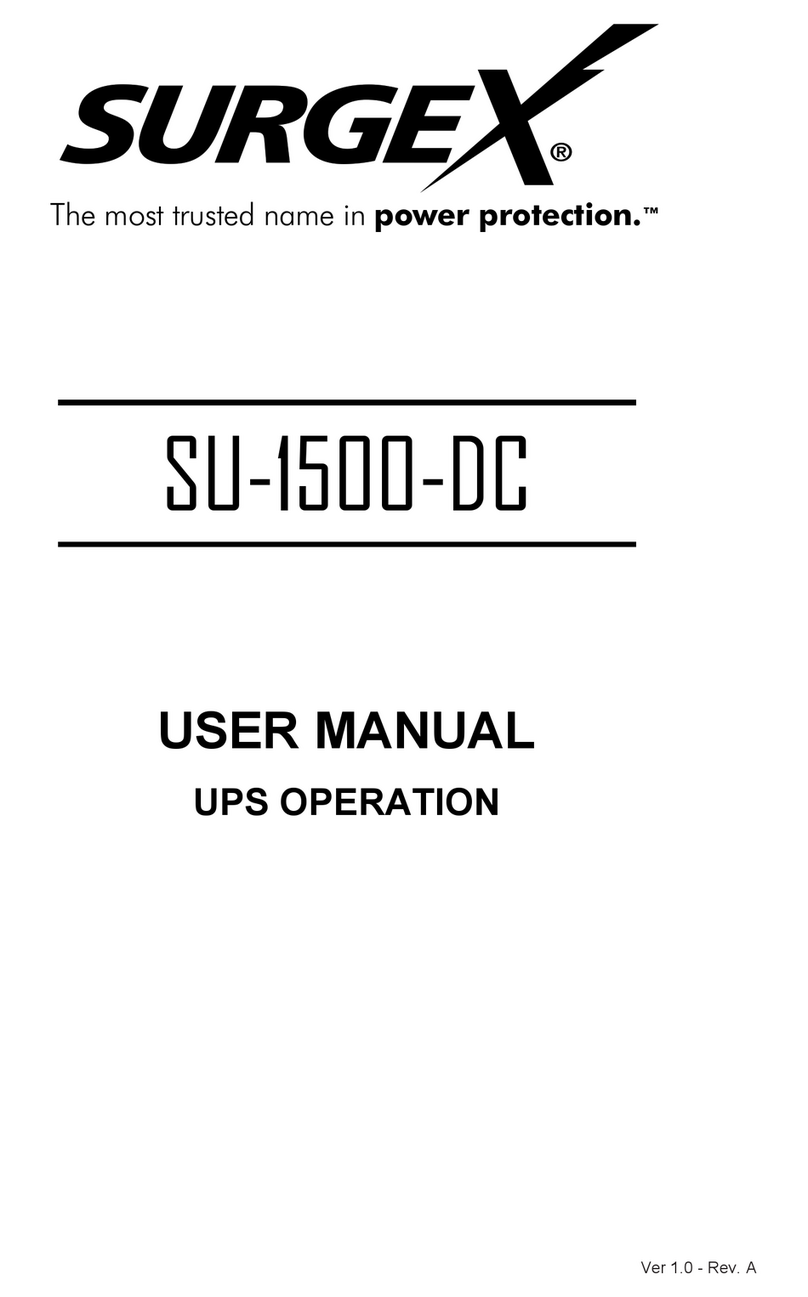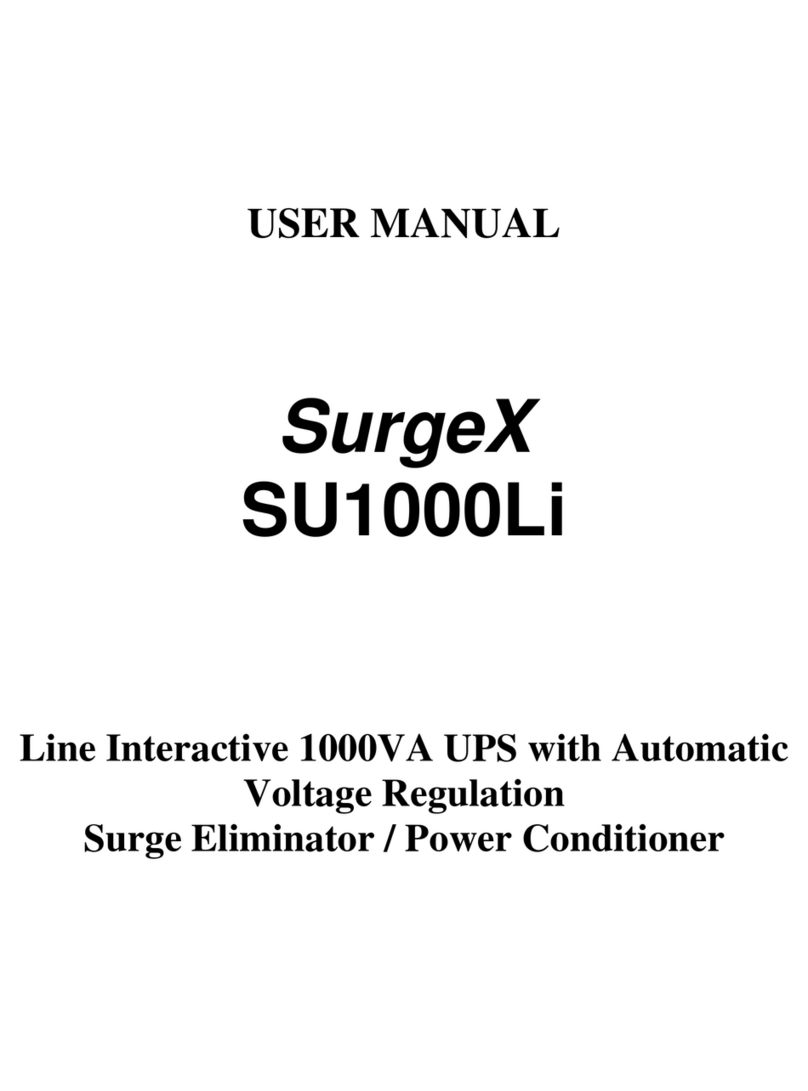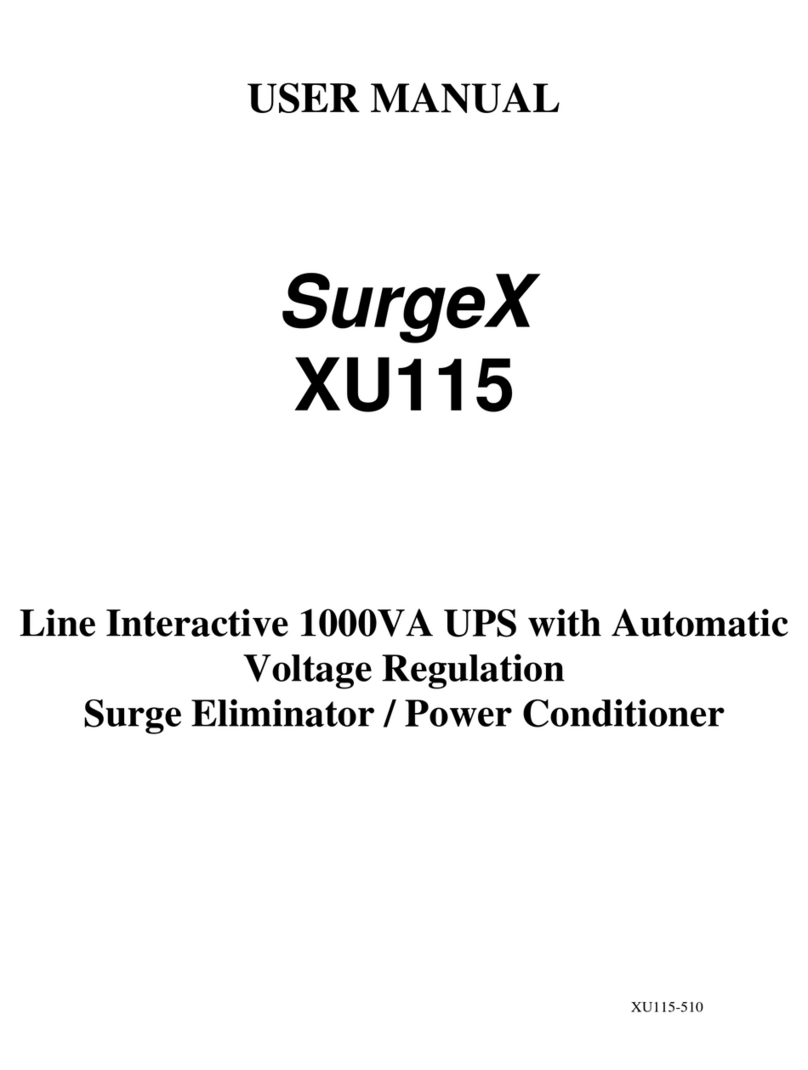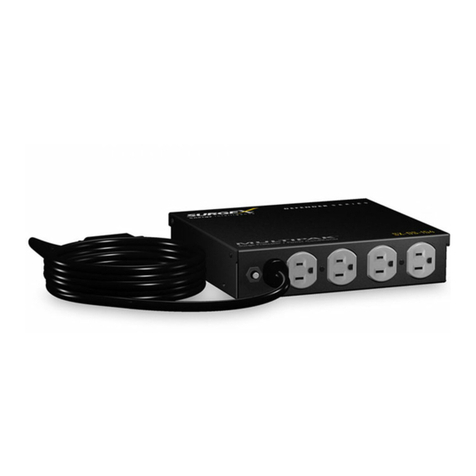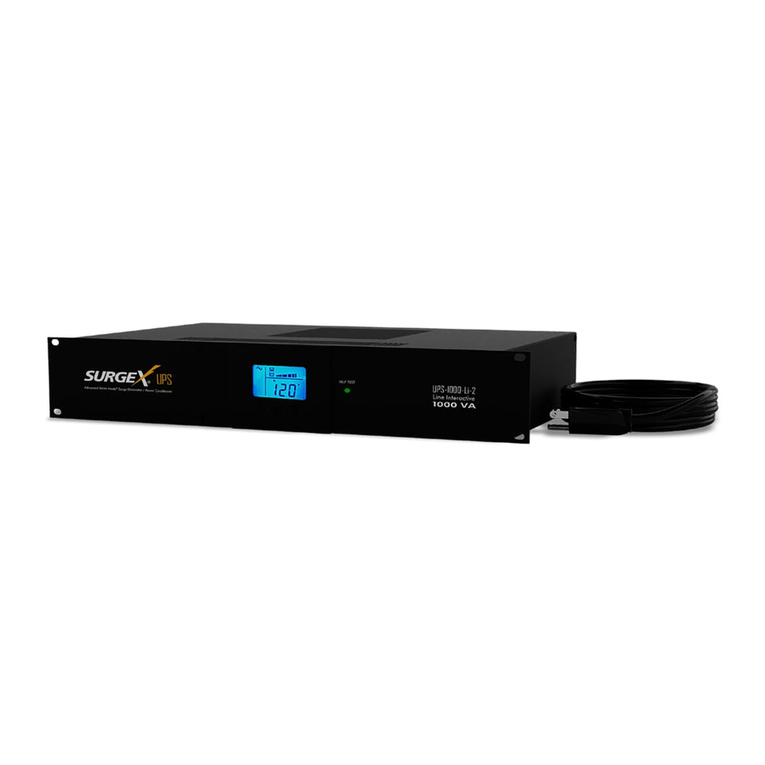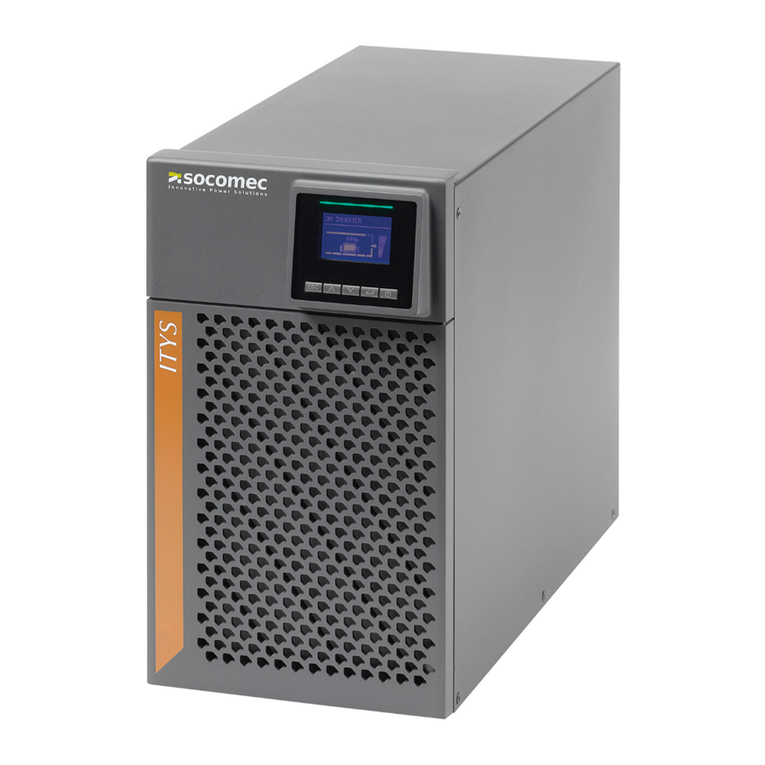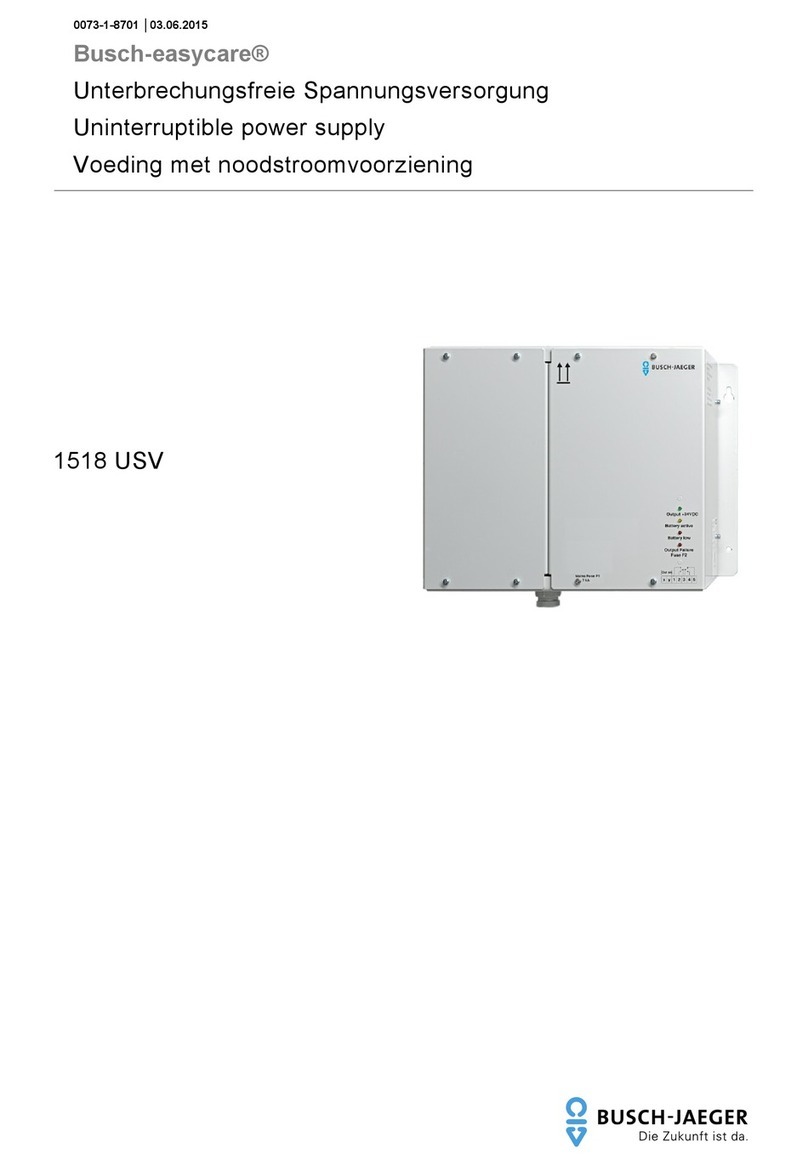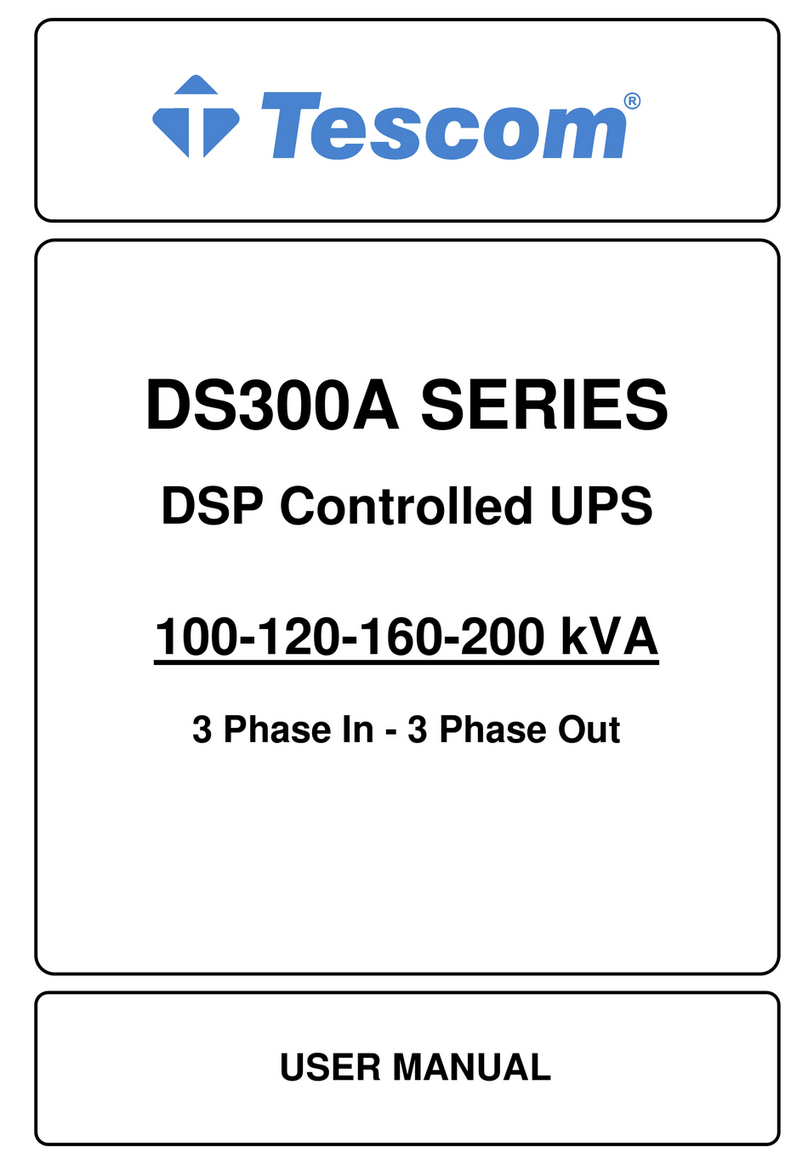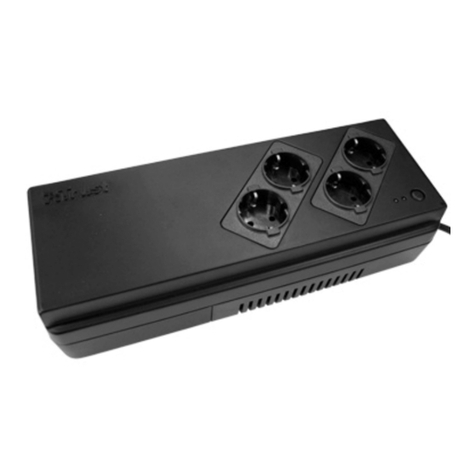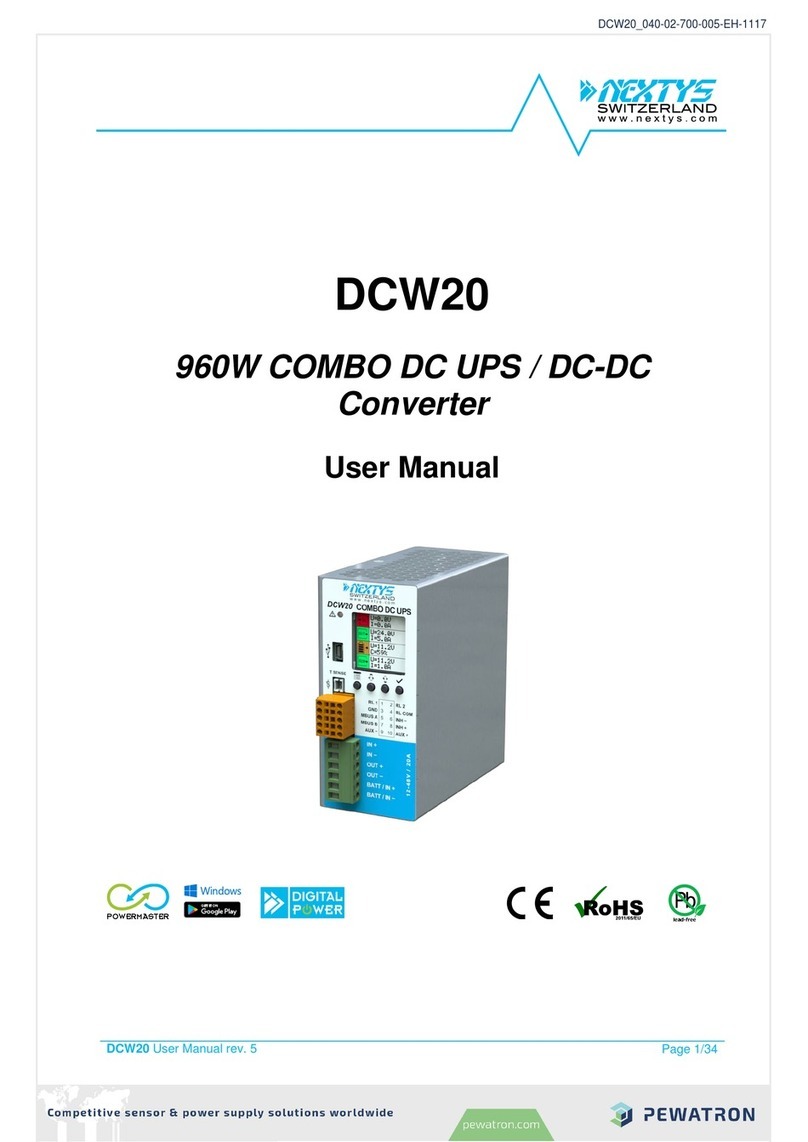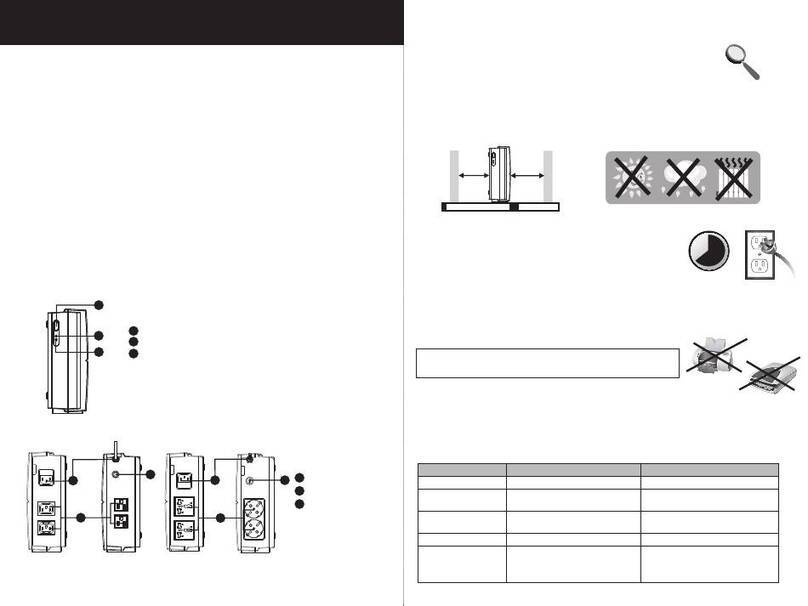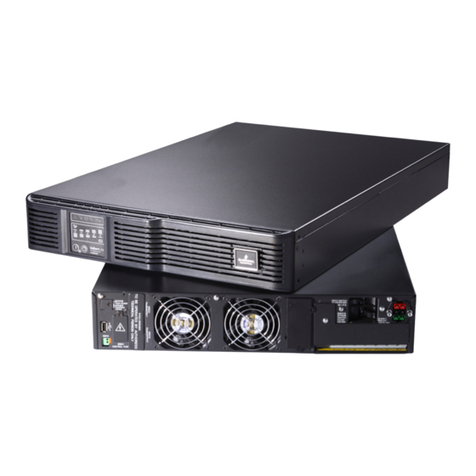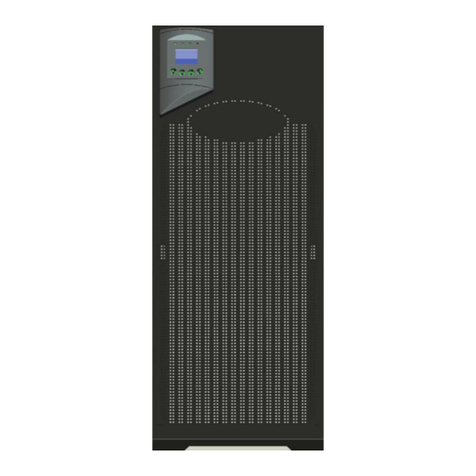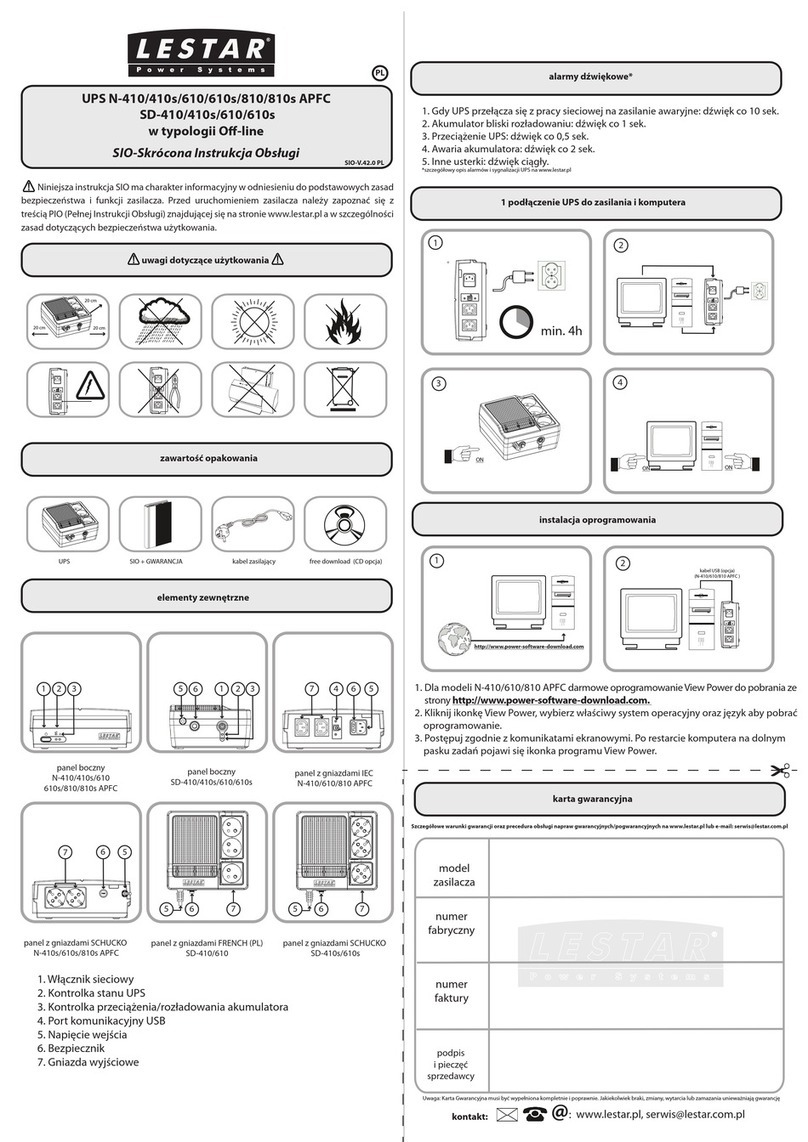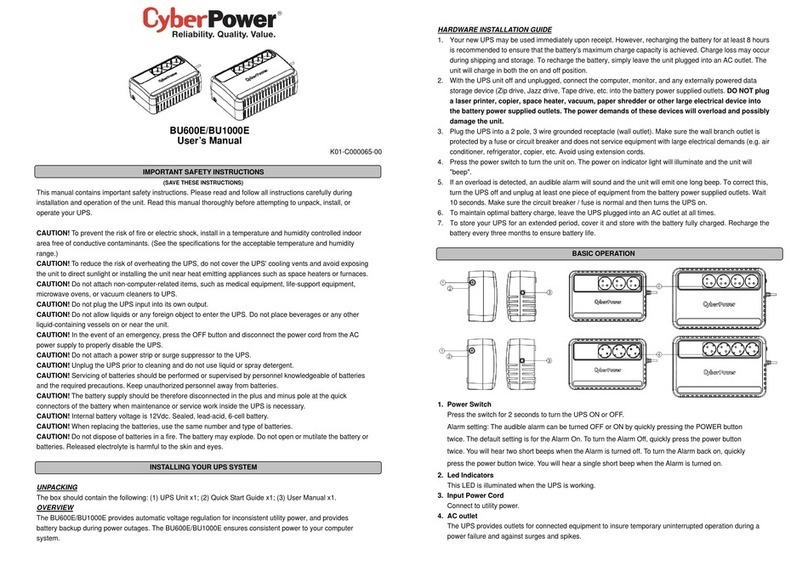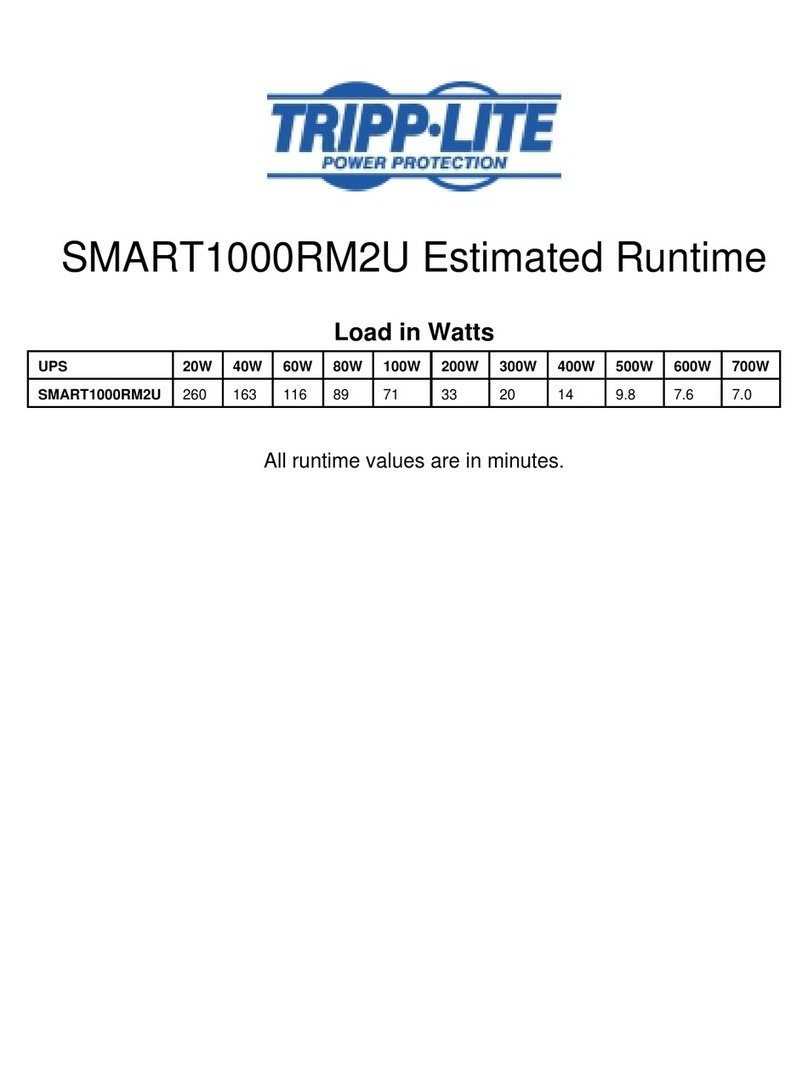SurgeX SU-2000Li User manual

Ver 1.0 - Rev. A
The most trusted name in power protection.™
USER MANUAL
UPS OPERATION
SU-2000Li

© 2011 SurgeX
1noitcudortnI.1
2. Controls and Indicators 5
8noitallatsnI.3
11noitarepO.4
14gnitoohselbuorT.5
15yrettaBehtgnicalpeR.6
18ecivreSgniniatbO.7
19snoitacificepS.8
9. Configurable Parameters & Settings 21
10. Limited Product Warranty 22
TABLE OF CONTENTS

IMPORTANT SAFETY INSTRUCTIONS
SAVE THESE INSTRUCTIONS !
Thank you for purchasing this power protection product. It has been designed
and manufactured to provide many years of trouble free service.
This symbol indicates "ATTENTION"
This symbol indicates "Risk of Electrical Shock"
This symbol indicates "Alternating Current Supply"
This symbol indicates "Alternating Current Supply Phase"
INTRODUCTION
1
1

WARNING: Risk of Electrical Shock. Hazardous live parts inside
these power supplies are energized from the battery even when the
AC input is disconnected.
CAUTION! To de-energize the outputs of the UPS:
1. If the UPS is on press and release the On/Off/Test button.
2. Disconnect the UPS from the AC wall outlet.
3. To de-energize the UPS completely, disconnect the battery.
CAUTION! To reduce the risk of electrical shock in conditions
where the load equipment grounding cannot be verified, disconnect
the UPS from the AC wall outlet before installing a computer interface
cable. Reconnect the power cord only after all signaling connections
are made.
CAUTION! Connect the UPS to a two pole, three wire grounding
AC wall outlet. The receptacle must be connected to the appropriate
branch protection (circuit breaker or fuse). Connection to any other
type of receptacle may result in a shock hazard and violate local
electrical codes. Do not use extension cords, adapter plugs, or surge
strips.
CAUTION! To reduce the risk of electrical shock with the installa-
tion of this UPS equipment and the connected equipment, the user
must ensure that the combined sum of the AC leakage current does
not exceed 3.5mA.
This symbol indicates "Direct Current Supply"
This symbol indicates "Equipment Grounding Conductor"
WARNING: This Uninterruptible Power Supply contains potentially
hazardous voltages. Do not attempt to disassemble the UPS beyond
the battery replacement procedure. This UPS contains no user ser-
viceable parts. Repairs and Battery replacement must be performed
by QUALIFIED SERVICE PERSONNEL ONLY.
2

After removing your UPS from its carton, it should be inspected for damage that
may have occurred in shipping. Immediately notify the carrier and place of
purchase if any damage is found. Warranty claims for damage caused by the
carrier will not be honored. The packing materials that your UPS was shipped
in are carefully designed to minimize any shipping damage. In the unlikely
case that the UPS needs to be returned to the manufacturer, please use the
original packing material. Since the manufacturer is not responsible for ship-
ping damage incurred when the system is returned, the original packing mate-
rial is inexpensive insurance. PLEASE SAVE THE PACKING MATERIALS!
Receiving Inspection
NOTICE: This equipment has been tested and found to comply with the limits
for a Class B computing device in accordance with the specifications in Sub-
part J of Part 15 of FCC Rules and the Class B limits for radio noise emissions
from digital apparatus set out in the Radio Interference of the Canadian Depart-
ment of Communications. These limits are designed to provide reasonable
protection against such interference in a residential installation. This equip-
ment generates and uses radio frequency and if not installed and used properly,
that is, in strict accordance with the manufacturer's instructions, this equip-
ment may cause interference to radio and television reception. If this equip-
ment does cause interference to radio or television reception, which can be
determined by turning the equipment off and on, the user is encouraged to try to
correct the interference by one or more of the following measures:
Re-orient the receiving antenna.
Relocate the computer with respect to the receiver.
Move the computer away from the receiver.
Plug the computer into a different outlet so that the computer and receiver
are on different branch circuits.
Shielded communications interface cables must be used with this product.
WARNING: Changes or modifications to this unit not expressly ap-
proved by the party responsible for compliance could void the user's
authority to operate the equipment.
NOTE: These UPSs are shipped with the batteries disconnected. The batter-
ies must be connected before putting these UPSs into service. Refer to Sec-
tion 3 "Installation" for connecting the batteries.
3

Life Support Policy
As a general policy, we do not recommend the use of any of our products in life
support applications where failure or malfunction of the product can be reason-
ably expected to cause failure of the life support device or to significantly affect
its safety or effectiveness. We do not recommend the use of any of our prod-
ucts in direct patient care. We will not knowingly sell our products for use in
such applications unless it receives in writing assurances satisfactory to us
that (a) the risks of injury or damage have been minimized, (b) the customer
assumes all such risks, and (c) our liability is adequately protected under the
circumstances.
Examples of devices considered to be life support devices are neonatal oxygen
analyzers, nerve stimulators (whether used for anesthesia, pain relief, or other
purposes), auto transfusion devices, blood pumps, defibrillators, arrhythmia
detectors and alarms, pacemakers, hemodialysis systems, peritoneal dialysis
systems, neonatal ventilator incubators, ventilators for both adults and infants,
anesthesia ventilators, and infusion pumps as well as any other devices desig-
nated as “critical” by the United States FDA.
Hospital grade wiring devices and leakage current may be ordered as options
on many of our UPS systems. We do not claim that units with this modification
are certified or listed as Hospital Grade by us or any other organization. There-
fore, these units do not meet the requirements for use in direct patient care.
4

The AC normal (green) LED illuminates in a steady state when the
UPS is on and operating in the AC normal mode. The AC normal
LED will extinguish when operating in the Battery mode.
The On-Battery (green) LED illuminates in a steady state when the
UPS is operating in the Battery mode. The On-Battery LED will
extinguish when operating in the AC normal, Boost and Buck modes.
The Boost (yellow) LED illuminates in a blinking state when the
UPS is operating in the Boost mode. The Boost LED will extinguish
when operating in the AC normal, Buck and Battery modes.
The Buck (yellow) LED illuminates in a blinking state when the UPS
is operating in the Buck mode. The Buck LED will extinguish when
operating in the AC normal, Boost and Battery modes.
The Fault (red) LED illuminates in a steady state when the UPS
detects an internal fault. The Fault LED is extinguished when the
UPS is operating properly.
The Weak/Bad Battery (red) LED illuminates in a steady state when
the UPS detects a weak battery, bad battery or if the battery is
disconnected. The Weak/Bad Battery LED is extinguished when
the battery's condition is good.
The Site Wiring Fault (red) LED (120V models) illuminates in a steady
state when the UPS detects a site wiring problem. The SWF LED is
extinguished when the UPS is connected to proper site wiring.
CONTROL PANEL
CONTROLS AND INDICATORS
2
5

The Load Level Bar Graph (AC mode only) operates as follows:
LED #10: >10% load (green/red/yellow) LED will be green and illu-
minated when there is at least 10% of the rated capacity.
LED #30: >30% load (green/yellow) LED will be green and illumi-
nated when there is at least 30% of the rated capacity.
LED #50: >50% load (green/yellow) LED will be green and illumi-
nated when there is at least 50% of the rated capacity.
LED #70: >70% load (green/yellow) LED will be green and illumi-
nated when there is at least 70% of the rated capacity.
LED #90: >90% to approximately 109% load (red/yellow) LED will
be yellow and illuminated when there is approximately 90% of the
rated capacity to indicate that unit is near full capacity. The LED
will turn red at 110% load capacity to indicate an Overload condi-
tion.
The Battery Capacity Bar Graph (Battery mode only) operates as
follows:
LED #90: >90% battery capacity (red/yellow) LED will be yellow
and illuminated until the battery’s capacity drops below 80% ca-
pacity and then it will extinguish.
LED #70: >70% battery capacity (green/yellow) LED will be yellow
and illuminated until the battery’s capacity drops below 60% ca-
pacity and then it will extinguish.
LED #50: >50% battery capacity (green/yellow) LED will be yellow
and illuminated until the battery’s capacity drops below 40% ca-
pacity and then it will extinguish.
LED #30: >30% battery capacity (green/yellow) LED will be yellow
and illuminated until the battery’s capacity drops below 30% ca-
pacity and then it will extinguish.
LED #10: >30% battery capacity (green/red/yellow) LED will be yel-
low and illuminated until the unit issues a Low Battery Warning
Alarm and then it will turn red to indicate a Low Battery Warning.
The Multi-Function On/Off/Test Button functions as follows:
When the UPS is Off, press and release the On/Off/Test button
after one beep to turn the UPS On.
When the UPS is On, press and release the On/Off/Test Button
after one beep to turn the UPS Off.
When the UPS is On, press and hold the On/Off/Test button for four
beeps, then release the button. The UPS will perform a 5-second
Self Test.
6

REAR PANEL
Output Power Receptacles
Model #
SU-2000Li NEMA 5-20P 6-NEMA 5-15/20R
1-NEMA L5-20R
Input Power Plug
(All power cords are 10ft)
1. The RS232 Communications Interface Port is for UPS monitoring and control.
1. The RS232 Communications Interface Port is for UPS monitoring and control.
2. The USB Communications Interface Port is for UPS monitoring and control.
3. The RJ11 REPO (Remote Emergency Power Off) Port is for UPS control.
4. The option slot is for option cards.
5. The External Battery Connector is for connecting External Battery Packs.
6. The output circuit breaker will trip in the event the load exceeds the UPS’s power rating.
7. The Battery Backup output power receptacles. The output receptacles are electrically
wired into two segments to support the "Load Shedding Function". The locking receptacle
does not support the Load Shedding Function. NOTE: The locking recptacle is not on all
models.
8. The input circuit breaker will trip in the event the load exceeds the UPS’s power rating.
9. The input power cord (120V models).
10. The dipswitch is for setting the Inverter (On-Battery) output voltage.
11. The External Ground Stud is for connecting an external ground wire.
12. The R-J11/R-J45 modular connectors are used for 10/100 Base-T Network/single line
Phone/Fax/Modem protection.
7

CONNECTING THE BATTERIES
(QUALIFIED SERVICE PERSONNEL ONLY)
Please read all of the WARNINGS and CAUTIONS before attempting to con-
nect the batteries.
1. Remove the UPS from the shipping box and set on the floor or a bench top.
2. Remove the front panel retaining screws.
3. Lay the front panel on top of the UPS.
4. Verify proper polarity. Connect the battery connectors (red and black) toge-
ther.
NOTE: Some sparking might occur, this is normal.
5. Re-install the front panel onto the UPS.
6. Re-install the front panel retaining screws.
7. Continue with the rest of the Installation.
INSTALLATION PLACEMENT
This UPS series is intended to be install in a temperature controlled environ-
ment that is free of conductive contaminants. Select a location which will
provide good air circulation for the UPS at all times. Avoid locations near heat-
ing devices, water or excessive humidity, or where the UPS is exposed to direct
sunlight. Route power cords so they cannot be walked on or damaged.
Operating Temperature (Maximum): 0 to 40 degrees C (+32 to +104 degrees F)
Operating Elevation: 0 to 3,000m (0 to +10,000 ft)
Operating and Storage Relative Humidity: 95%, non-condensing
Storage Temperature: -15 to +45 degrees C (+5 to +113 degrees F)
Storage Elevation: 0 to 15,000m (0 to +50,000 ft)
INSTALLATION
Be sure to read the installation placement and all the cautions before installing
the UPS. Place the UPS in the final desired location and complete the rest of
the installation procedure. These UPSs are shipped with the internal batteries
disconnected. The batteries must be connected before putting these UPSs
into service. See the connecting the batteries procedure to connect the batter-
ies and see the Rackmount Configuration to install the UPS into the rack. USE
CAUTION: The UPS is heavy. Use the appropriate number of personnel when
installing the UPS.
INSTALLATION
3
8

RACKMOUNT CONFIGURATION
This UPS comes with mounting brackets for the standard 19" (46.5cm) rack.
The mounting brackets to fit a 23" (59.2cm) standard rack are also available.
The screws for mounting the UPS to the rack are not included (screw size
varies with rack size).
1. Locate the mounting bracket screw holes on the side panels of the UPS, at
the front of the UPS. NOTE: The mounting brackets can also be mounted
in the middle of the UPS.
2. Align the mounting bracket with the mounting bracket screw holes.
3. Attach the mounting bracket with the retaining screws.
4. Mount the UPS into the rack and secure with the retaining screws. WARN-
ING: Use two or more people when installing the UPS. Use CAUTION, the
UPS is extremely heavy. Do not move the rack after the units have been in-
stalled. The rack maybe unstable due to the weight distribution.
5. The Rackmount Configuration is complete. See Connecting your Equipm-
ent.
9

CHARGING THE BATTERY
CHECKING THE SITE WIRING FAULT (120V Models)
After plugging in the UPS, check the Site Wiring Fault (SWF) LED on the front
panel of the UPS. If the SWF LED is illuminated, the UPS is plugged into an
improperly wired AC outlet. If the UPS indicates a Site Wiring Fault (SWF),
have a Qualified Electrician correct the problem.
COMMUNICATIONS PORT CONNECTION (OPTIONAL)
The Power Monitoring Software and interface cables can be used with the UPS.
Use only the interface cables that come with these UPSs. Connect the inter-
face cable (Serial or USB) to the appropriate communications port on the rear
panel of the UPS. Connect the other end of the cable to the device that will be
monitoring/controlling the UPS. NOTE: Connecting to the Communications
Port is optional. The UPS works properly without this connection.
CONNECTING THE UPS TO AN AC SOURCE
Plug the UPS into a two pole, three wire, grounded receptacle only. Do not use
extension cords, adapter plugs, or surge strips.
NETWORK/PHONE/FAX/MODEM PROTECTION CONNECTION (OPTIONAL)
Connect a 10/100 Base-T network, single line phone, Fax or Modem line to the
RJ11/45 modular connectors on the rear panel of the UPS. This connection will
require another length of telephone or network cable. The cable coming from
the telephone service or networked system is connected to the port marked
“IN”. The equipment to be protected is connected to the port marked "OUT".
NOTE: Connecting to the Network/Phone/Fax/Modem modular connectors is
optional. The UPS works properly without this connection.
CONNECTING YOUR EQUIPMENT
Plug the equipment into the output receptacles on the rear panel of the UPS.
Do not use extension cords, adapter plugs or surge strips on the output of the
UPS. Ensure that you do not exceed the maximum output rating of the UPS
(refer to the information label or the Electrical Specifications in this manual).
CAUTION! DO NOT connect a laser printer to the output receptacles on the
UPS, unless the UPS is rated 2000VA or greater. A laser printer
draws significantly more power when printing than at idle and
may overload the UPS.
RJ11 REPO (Remote Emergency Power Off) PORT (OPTIONAL)
Connect one end of the RJ11 cable to the REPO port and the other end of the
RJ11 cable to the EPO switch. In the AC or the Battery mode short pin4 to pin5
for approximately 0.5-seconds to shutdown the UPS. The UPS must be turned
off and then back on again to restart the UPS. NOTE: Connecting to the
REPO port is optional. The UPS works properly without this connection.
The UPS will charge the internal batteries whenever the UPS is connected to
an AC source and there is an acceptable AC voltage present. It is recommended
that the UPS's batteries be charged for a minimum of 4 hours before use. The
UPS may be used immediately, however, the “On-Battery” runtime may be
less than normally expected. NOTE: If the UPS is going to be out of service or
stored for a prolonged period of time, the batteries must be recharged for at least
twenty-four hours every ninety days.
10

SYSTEM OVERVIEW
This Line-Interactive UPS protects computers, internetworking, and telecom-
munications equipment from blackouts, brownouts, overvoltages, and surges.
The AVR function continuously corrects the voltages, in-between the brownout
and overvoltage transfer points (80 - 164VAC/150 - 271VAC), to a safe usable
level. When the UPS is operating in the AVR mode the audible alarm will
remain silent and the Boost or the Buck indicator will blink. During normal AC
operation, the UPS will quietly and confidently protect your system from power
anomalies.
The UPS will charge the batteries with the UPS in the on or off position as long
as the UPS is plugged into the wall outlet and there is an acceptable AC voltage
present (80 - 164VAC/150 - 271VAC). When a blackout, brownout, or an
overvoltage condition occurs; the UPS will transfer to the battery mode, the On-
Battery indicator will illuminate and the audible alarm will sound once every ten-
seconds indicating that the commercial power is lost or unacceptable. When
the commercial power returns or is at an acceptable level, the UPS will auto-
matically transfer back to the AC normal mode and start recharging the batter-
ies. During an extended outage when there is approximately two-minutes of
backup time remaining the audible alarm will sound twice every five-seconds.
This Low Battery Warning is letting the user know that they should save all
open files and turn off their computer. When the batteries reach the predeter-
mined level the UPS will automatically shutdown protecting the batteries from
over discharging. Once the commercial power returns the UPS will automati-
cally restart, providing safe usable power to the connected equipment and start
recharging the batteries.
TURNING THE UNIT ON/OFF
On / Off / Test Button
OPERATION
4
Press and release the On/Off/Test Button after one beep to turn the UPS on
and supply power to the load. The load is immediately powered while the UPS
runs a five-second self test. Press and release the On/Off/Test Button after one
beep to turn the UPS off. The UPS will continue to charge the batteries when-
ever it is plugged into a wall outlet and there is acceptable AC voltage
present.
11

COMMUNICATIONS PORTS (RS232 and USB)
The RS232 communication port is a standard DB9 female with both RS232 and
simulated contact closure capability. The UPS will poll the port and activate
the port for RS232 or contact closure in accordance with the type of cable it
finds connected to the port. To change the port configuration requires the unit
be turned off and restarted with the desired cable connected. The pinout for the
port is depicted per the chart below:
Pin 1: Simulated contact closure Low Battery Warning, NO
Pin 2: /TXD
Pin 3: /RXD and receive UPS shutdown command (connect to pin 9 for 4-
seconds. The shutdown command is only active in the battery mode)
Pin 4: Not Used
Pin 5: Ground
Pin 6: Not Used
Pin 7: Not Used
Pin 8: Simulated contact closure AC fail, NO
Pin 9: Atx Signal (high level: +12V +/-2V, low level: -15V +/- -2V)
DIPSWITCH SETTINGS
The dipswitch setting may be changed by the user to set the desired Inverter
(On-Battery) output voltage. The dipswitch must be set to the desired Inverter
(On-Battery) output voltage and then the UPS must be turned off and restarted
to reconfigure the microprocessor and save the changes. The Inverter (On-
Battery) output voltage setting can be either 120VAC (208VAC) default or 127VAC
(240VAC). Changing the Inverter (On-Battery) output voltage to 127VAC, will
also change the Buck setpoint. Changing the Inverter (On-Battery) output volt-
age to 240VAC, will also change the Brownout, Boost, Buck and Overvoltage
setpoints.
SELF TEST
The self test feature is useful to verify the correct operation of the UPS and the
condition of the batteries. With the UPS in the AC normal mode, press and
hold the On/Off/Test Button for four beeps, then release the button. The UPS
will perform a ten-second self test. During the self test, the UPS will switch to
battery power and the On-Battery LED will illuminate and the audible alarm will
sound. The length of the test that is automatically performed every two weeks
is longer than the start-up or user invoked test. This test will run for approxi-
mately fifteen-seconds to measure the battery’s capability to provide an ac-
ceptable amount of runtime. If the UPS fails a self test, one of the LEDs will
remain illuminated indicating the type of problem. NOTE: The UPS will auto-
matically perform a self test on start-up and every two weeks.
LOAD SHEDDING FUNCTION
The output receptacles are electrically wired into two segments to support the
"Load Shedding Function". The user can control the two segments individually
or both at the same time. The Load Shedding Function is controllable by the
Power Monitoring Software or the SNMP card.
12

WEAK/BAD BATTERY
The UPS automatically tests the battery’s condition and will illuminate the Weak/
Bad Battery LED and sound the alarm. This alarm will be repeated until the
batteries pass a self test. If the battery is weak, bad or disconnected, the
Weak/Bad Battery LED will illuminate and the alarm will beep three times every
five-minutes until the battery is reconnected or replaced. It is recommended
that the UPS be allowed to charge overnight before performing a battery test to
confirm a Weak/Bad Battery condition.
NOTE: If the UPS has a Weak/Bad Battery Alarm after reconnecting or replac-
ing the batteries, the user must initiate a self test to clear the Weak/Bad Bat-
tery Alarm. To initiate a self test see section 4 "SELF TEST".
OVERLOAD
When the amount of load attached to the UPS exceeds its power rating, the
Overload LED will illuminate (AC mode only) and the UPS will sound a constant
alarm (AC and Battery modes). This alarm will remain on until the excess load
is removed or the UPS’s self protection circuit shuts the UPS down. If the UPS
shuts down because of an Overload condition in the battery mode, the UPS
must perform an Inverter function or a Self Test to clear the Overload Alarm.
POWER MONITORING SOFTWARE
The UPS comes with a Power Monitoring Software CD. See the software CD
for the installation of the Power Monitoring Software.
USB PORT
The USB protocol is HID. The HID USB driver is standard in the Windows OS.
Simply plug the USB cable into the UPS and the computer then follow the
prompts on the screen.
OPTION SLOT
The option slot on the rear panel of the UPS is for option cards. Contact your
local dealer for the available option cards.
ALARMS
ON BATTERY
When the UPS is operating on the batteries, the On-Battery LED will illuminate
and the audible alarm will sound once every ten-seconds. The alarm will stop
once the UPS returns to the AC normal mode.
LOW BATTERY WARNING
The UPS will sound two beeps every five-seconds when the battery reserve
runs low. This condition will continue until AC returns or the UPS shuts down
from battery exhaustion.
UPS FAULT
When the UPS detects a hardware fault, the Fault LED will illuminate and the
UPS will sound a constant alarm. The fault condition, in some instances, may
be reset by turning the UPS off and then on.
RJ11 REPO (Remote Emergency Power Off) PORT
Connect one end of the RJ11 cable to the REPO port and the other end of the
RJ11 cable to the EPO switch. In the AC or the Battery mode short pin4 to pin5
for approximately 0.5-seconds to shutdown the UPS. The UPS must be turned
off and then back on again to restart the UPS.
13

Possible Cause
Symptom What To Do
Press and release the On/Off/
Test button to start UPS
On/Off/Test button not
pushed
UPS will not turn on
Reset circuit breaker by
pressing the plunger back in.
If the AC circuit breaker trips
after UPS starts up, reduce
the load on the UPS
UPS operates in
battery mode only,
even though there
is normal AC
present
Input AC circuit breaker is
tripped
UPS has detected an
internal fault
Call for service
Fault LED is
illuminated
The AC normal
LED is illuminated,
but there is no out-
put
Incorrect service wiring
Disconnect the computer
cable from the UPS and press
the On button. If UPS works
normally, the software has
control of the UPS
The UPS is being
controlled via its
communications port
Site Wiring Fault
LED is illuminated
Have a Qualified Electrician
correct the service wiring
The batteries may be weak
or at the end of useful
service life
Charge the batteries for 8-
hours and retest. If the runtime
is still less than expected, the
batteries may need to be
replaced, even though the
Weak/Bad Battery LED is not
illuminated
UPS does not
provide expected
runtime
Weak/Bad Battery
LED is illuminated
Overload LED is
illuminated and a
constant alarm
The Boost LED or
Buck LED is blink-
ing.
UPS occasionally
emits a beep
Loose connections at the
batteries, Weak batteries,
Bad batteries
Normal operation
The load has exceeded the
UPS's capacity
The UPS is in either the
Boost mode or the Buck
mode
Check battery connections,
charge the batteries for 8-
hours, replace the batteries
The UPS is performing its
intended function
Check the specifications (see
section 8). Remove part of
the load
The UPS is performing its
intended function
TROUBLESHOOTING
5
14

REPLACING THE BATTERY
WARNING! This Uninterruptible Power Supply contains potentially hazardous
voltages. Do not attempt to disassemble the UPS beyond the
battery replacement procedure. This UPS contains no
user serviceable parts. Repairs and Battery replacement must
be performed by QUALIFIED SERVICE PERSONNEL ONLY.
Do not open or mutilate batteries. Released electrolyte is harmful
to the skin and eyes and may be toxic.
CAUTION:
(QUALIFIED SERVICE PERSONNEL ONLY)
CAUTION: Do not dispose of batteries in a fire. The batteries may explode.
The batteries in this UPS are recyclable. Dispose of the batter-
ies properly. The batteries contain lead and pose a hazard to the
environment and human health if not disposed of properly. Refer
to local codes for proper disposal requirements or return the
battery to the supplier.
Although battery system voltages are only 36VDC and 72VDC
the battery system can still present a risk of electrical shock.
These batteries produce sufficient current to burn wire or tools
very rapidly, producing molten metal. Observe these precautions
when replacing the batteries:
1. Remove watches, rings, or other metal objects.
2. Use hand tools with insulated handles.
3. Wear protective eye gear (goggles), rubber gloves and boots.
4. Do not lay tools or other metal parts on top of batteries.
5. Disconnect the charging source prior to connecting or disco-
nnecting the battery terminals.
6. Determine if the battery is inadvertently grounded. If the bat-
tery is, remove the source of the grounding. Contact with any
part of a grounded battery can result in an electrical shock.
The likelihood of such shock will be reduced, if such grounds
are removed during installation and maintenance.
CAUTION:
This UPS has an easy to replace hot-swappable batteries. Please read all of
the WARNINGS and CAUTIONS before attempting to service the batteries.
NOTE: If there is a power interruption while replacing the hot-swappable batter-
ies, with the UPS on, the load will not be backed up.
REPLACING THE BATTERY
6
15

BATTERY REPLACEMENT PROCEDURE
PLEASE READ THE CAUTIONS AND WARNINGS BEFORE ATTEMPTING
TO REPLACE THE BATTERIES
Hot-swappable batteries mean that the batteries can be replaced without
powering down the whole UPS system.
NOTE: If there is a power interruption while replacing the hot-swappable batter-
ies, with the UPS on, the load will not be backed up. To hot-swap the batteries
start with step number 6.
1. Turn off the equipment that is plugged into the output receptacles of the
UPS.
2. Press and release the On/Off/Test button on the front panel to turn the UPS
OFF. NOTE: Turn the input circuit breaker to the off position for the 208V
models.
3. Unplug the UPS's AC power cord from the AC wall outlet.
4. Unplug the equipment from the output receptacles of the UPS.
5. Unplug the computer interface cable from the rear panel of the UPS.
6. Remove the front panel retaining screws. (FIG. 2)
7. Lay the front panel on top of the UPS.
SU-2000Li
Battery Qty/Rating 6-12V7.2Ah
Model #
Replace batteries with the same number and type as originally
installed in the UPS. These batteries have pressure operated vents.
These UPSs contain sealed non-spillable maintenance-free lead
acid batteries.
CAUTION:
Panasonic Part #
Yuasa Part #
CSB Part #
NP-7.2-12
LC-R127.2
GP 1272 F2
16

8. Remove the two retaining screws for the battery retaining bracket. (FIG. 3)
9. Remove the battery retaining bracket. (FIG. 3)
10. Disconnect the Battery connectors (red and black). (FIG. 4)
11. Grasp the battery pull tab and gently pull the battery module out of the UPS
and set on the floor. (FIG. 4)
NOTE: Use Caution, the battery module is heavy.
12. Disconnect the battery positive (red) wire.
13. Disconnect the battery negative (black) wire.
14. Remove the battery jumper wires.
15. Remove the old batteries from the battery module.
16. Install the new batteries into the battery module in the same position as the
original batteries.
17. Verify proper polarity. Re-install the battery jumper wires on the new batt-
eries.
18. Verify proper polarity. Reconnect the battery negative (black) wire.
19. Verify proper polarity. Reconnect the battery positive (red) wire.
20. Slide the battery module into the UPS.
21. Verify proper polarity. Reconnect the battery connectors (red and black).
NOTE: Some sparking might occur, this is normal.
22. Re-install the battery retaining bracket.
23. Re-install the two retaining screws for the battery retaining bracket.
24. Re-install the front panel on the UPS.
25. Re-install the front panel retaining screws.
26. Properly dispose of the old batteries at an appropriate recycling facility or
return them to the supplier in the packing material for the new batteries.
27. The UPS is now ready for the normal operation.
NOTE: If the UPS has a Weak/Bad Battery Alarm after replacing the batteries,
the user must initiate a self test to clear the Weak/Bad Battery Alarm. To
initiate a self test see section 4 "SELF TEST".
17

IF THE UPS REQUIRES SERVICE
1. Use the TROUBLESHOOTING section to eliminate obvious causes.
2. Verify there are no circuit breakers tripped. A tripped circuit breaker is the
most common problem.
3. Call your dealer for assistance. If you cannot reach your dealer, or if they
cannot resolve the problem call or fax the Technical Support department at
1-800-645-9721. Please have the following information available BEFORE
calling the Technical Support Department
A. Your name and address.
B. Where and when the unit was purchased.
C. All of the model information about your UPS.
D. Any information on the failure, including LEDs that may be illuminated.
E. A description of the protected equipment, including model numbers if pos-
sible.
F. A technician will ask you for the above information and, if possible, help
solve your problem over the phone. In the event that the unit requires
factory service, the technician will issue you a Return Material Authoriza-
tion Number (RMA #).
G. If the UPS is under warranty, the repairs will be done at no charge. If not,
there will be a charge for repair.
4. Pack the UPS in its original packaging. If the original packaging is no longer
available, ask the Technical Support Technician about obtaining a new set.
It is important to pack the UPS properly in order to avoid damage in transit.
Never use Styrofoam beads for a packing material.
A. Include a letter with your name, address, day time phone number, RMA
number, a copy of your original sales receipt, and a brief description of the
problem.
5. Mark the RMA # on the outside of all packages. The factory cannot accept
any package without the RMA # marked on the outside.
6. Return the UPS by insured, prepaid carrier to:
OBTAINING SERVICE
7
SurgeX
517 North Industrial Dr.
Zebulon, NC 27597
18
Table of contents
Other SurgeX UPS manuals
